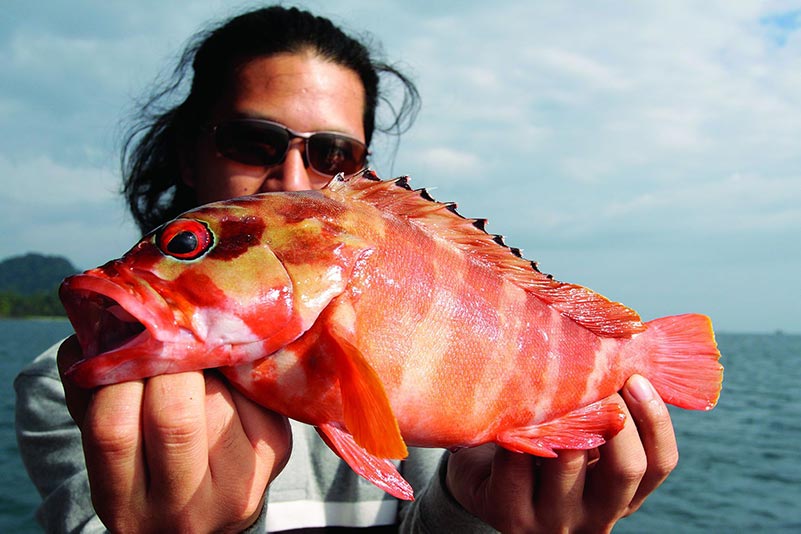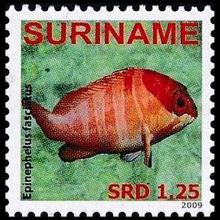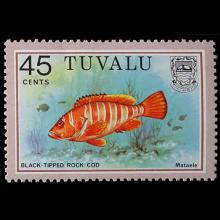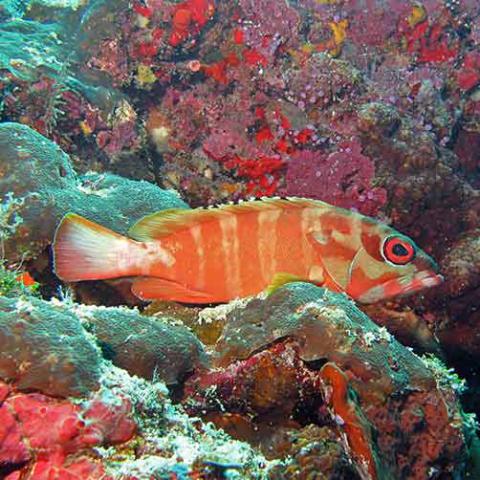NAMES
TAXONOMY
Suriname
Issued:
Stamp:
Epinephelus fasciatus
Tuvalu
Issued:
Stamp:
Epinephelus fasciatus
Suriname
Issued:
Stamp:
Epinephelus fasciatus
Tuvalu
Issued:
Stamp:
Epinephelus fasciatus
Suriname
Issued:
Stamp:
Epinephelus fasciatus
Tuvalu
Issued:
Stamp:
Epinephelus fasciatus
Nov. 17, 2006
Sport Fishing readers try to stump the Fish Facts experts with strange catches.
Question: During a recent visit to Ko Kut Island, in the Gulf of Siam, we encountered a number of different species of grouper. I assume this one is a grouper, but know nothing about it and can't find any references that will ID it. Help me out, please! - Jean-Francois Helias, Fishing Adventures Thailand

Answer: This feisty little specimen is called the blacktip grouper, Epinephelus fasciatus. Also known as blacktip rock cod, it's a common species found around coral reefs throughout the Indo-Pacific, from the Red Sea in the west to as far east as Pitcairn Island. Indeed, they are considered to be one of the two most widely distributed species of grouper in the world, with six different populations identified within their range. They grow only to around 18 inches long, and so are one of the smaller members of the family Serranidae. The species is usually found on reef or rubble slopes in depths less than 130 feet, but they have been captured as deep as 500 feet. They're easily recognized by the black tip of the dorsal fin, which contrasts sharply with the banded orange of the body. Like other serranids, blacktip rock cod are protogynous hermaphrodites: They mature first as females, at 8 to 10 inches long, before switching sex to become male. These small but aggressive ambush predators can sometimes be seen sitting with their pectoral fins on the bottom in the coral, looking up at passing fish (and fishers), waiting to consume crustaceans and fish small enough to fit in their mouth. An excellent food fish, the species has become popular for aquaculture in Asia.
— Ben Diggles
Genus species (Animalia): Epinephelus fasciatus
The blacktip grouper (Epinephelus fasciatus), also known as the redbanded grouper, blacktipped cod, black-tipped rockcod, footballer cod, red-barred cod, red-barred rockcod, scarlet rock-cod or weathered rock-cod, is a species of marine ray-finned fish, a grouper from the subfamily Epinephelinae which is part of the family Serranidae, which also includes the anthias and sea basses. It is found in the tropical Indo-Pacific region. It is the type species of the genus Epinephelus.
Description
The blacktip grouper has a body which has a standard length which is around 2.8 to 3.3 times its depth. The area between the yes is flat but the dorsal profile of the head is convex. The rounded preopercle has a finely serrated rear margin with he lowest serrations slightly enlarged. The upper edge of the gill cover is straight. The dorsal fin contains 11 spines and 15-17 soft rays while the anal fin has 3 spines and 8 soft rays. The membranes between the dorsal fin spines are deeply indented. The caudal fin is moderately rounded. There are 49-75 scales in the lateral line. The color is variable and ranges from pale greenish grey to pale reddish yellow to scarlet. They frequently have 5 or 6 faint dark bars, the final one being on the caudal peduncle. The scales on the upper body have a pale center and dark rear margin, which creates am indistinct checked pattern. The outer membrane of the spiny part of the dorsal fin is black, or dark red in specimens from Western Australia and some from deep water. There is a pale yellow or white spot to the rear of the tip of each of the dorsal fin spines. This species attains a maximum total length of 40 centimeters (16 in), although a more common length is around 22 centimeters (8.7 in), and a weight of 2.0 kilograms (4.4 lb).
Distribution
The blacktip grouper has a wide Indo-Pacific distribution. Its range extends from the Red Sea to the Eastern Cape in South Africa east as far as the Pitcairn Islands, north to southern Japan and Korea and south to New Caledonia and Australia. It is found in the Madagascar, Mascarenes, Comoros and the Seychelles in the Indian Ocean as well. In Australia it occurs from the Houtman Abrolhos in Western Australia north around the tropical coastline and then as far south as Port Hacking in New South Wales. It can also be found on reefs in the Coral Sea, Elizabeth Reef, around Lord Howe Island in the Tasman Sea and Christmas Island.
Biology
This species may present simultaneous hermaphroditism in smaller individuals, while the large individuals usually lose female function.
The blacktip grouper feeds on crustaceans and smaller fishes by ambushing them. It is found associated with coral reefs from 4 m deep (more commonly from 15 m) up to 160 m, in both marine and brackish water, sometimes in groups of 10-15 individuals. Juveniles may find shelter in mangrove swamps.
Blacktip groupers of the Red Sea are fished by the Bedouin. It has also been associated with ciguatera poisoning.
Reference: Wikipedia, iNaturalist



